|
Memory and Memorial
Thousands of soldiers can claim Manteuffel
Kaserne / Daley Barracks as a former duty station. German veterans
of the 2 Kradschutzen and 13th Medical Replacement Battalion may now
number less than one hundred. The horrific casualty rates and
passing years have winnowed their numbers. Among the Americans,
soldiers who can say, " yes, I was there! " will remain well past
the middle of this century. Here, the results of how honor, memory
and memorial have tried to intersect on a hill above the city of Bad
Kissingen and the near border region.
2 Kradschutzen Battalion
Memorial
The Veterans Organization of the 2nd Panzer
Division was formed in June of 1959 in Vienna. The purpose was
straightforward, to provide fellowship for those men who had served
with the division, to pool their collective memories to assist
historians understand the role of the unit in the war and to insure
that the honorable reputation of the unit and the German Army was
maintained. They saw themselves as both victims of the criminal
political leadership who had led them into war and also as honorable
warriors who had fulfilled their military duty. The organization
published a newsletter detailing events of note and held periodic
reunions into the 1990s in cities associated with the past history
of the division. At least twice, 1969 and 1981, the reunion was held
in Bad Kissingen.
| |
 |
|
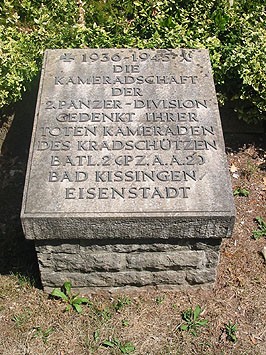 |
|
| |
May 1969, the Veteran's
Association of the 2 Panzer Division reunion held in Bad Kissingen. |
|
Memorial marker to the 2
Krad Battalion placed in the city park area of Bad Kissingen.
--Erwin Ritter |
|
The German humorist Willie Franz, with a
wink to his audience, recalled his own veteran’s reunion:
" ... and so it came time for the reunion
and I went like I always did, dressed in my worst suit with a patch
sewn on the sleeve. I hopped no one would ask me for a donation! At
the table I sat with my friends, we sang the old songs, lied about
our heroism and told the truth about our new, good lives as Germany
prospered ... and silently prayed thanks to God for our chance to
reminisce, lie and brag, so many comrades were absent forever. The
man who had been my commander worked for the trucking company, the
man who had been my driver owned the trucking company! At my table,
one man had lost an arm, another, both legs, one more could not see
and the fourth could barely hear. Put us all together and you could
just about assemble one full German!! But we were alive, having
survived a great nightmare we shared in the new dreams. "
A major event of each 2 Panzer Division
reunion was the dedication of a memorial marker which reflected the
historical relationship of the particular city and their unit.
Schweinfurt, home to the anti - tank battalion when the 2 Krad was
in Bad Kissingen, hosts an impressive stone memorial erected through
the efforts of these veterans. It appears that the major event of
the 1981 reunion was the placing of monument dedicated to the 2 Krad
battalion. The logical place would have been at Manteuffel / Daley
but this idea was soon dropped. The city was petitioned for a
suitable spot in the park and gardens along the Saale River and this
was granted.
The reunion went on as planned; the memorial
marker was officially unveiled before the bowed heads of the
survivors. A few years later, the 2nd Panzer veterans placed another
memorial to recall the members of the 2 Krad in the Austrian city of
Eisenstadt. This was the garrison home following Bad Kissingen.
| |
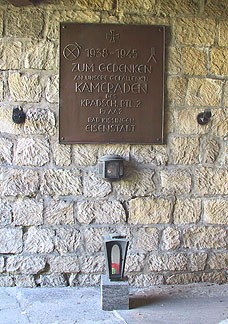 |
|
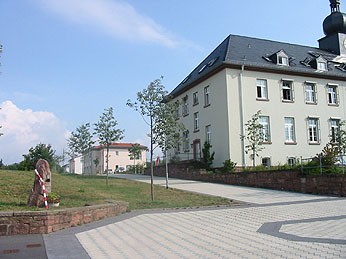 |
|
| |
At a reunion held in
Eisenstadt, 2 Panzer vets placed this marker.
--Stadt Eisnenstadt Burgermeister |
|
The Father Reinisch
memorial by our former Dining Facility.
--Erwin Ritter |
|
Catholic Priest Franz Reinisch Memorial
A simple memorial to a simple priest, who
placed his moral convictions above his own life, was placed within
the boundaries of the former Manteuffel / Daley Barracks in 2000.
Franz Reinisch, born 1 February 1903 as the
son of tax official Dr. Franz Reinisch and his wife Maria in
Feldkirch-Levis, was ordained as a priest on 29 June 1928 in the
parish church St. Jakob in Innsbruck, Austria. In 1930, he entered
the "Pallottinerorden" (Pallottine order), and shortly afterwards
became known in the "Schoenstattbewegung" (Schoenstatt movement), a
renewal movement for priests and lay people that was influenced by
Marianism. Father Franz Reinisch was active as a preacher leader of
retreat days in many places in Germany, and began early on to
confront the emerging ideology of National Socialism. On 12
September 1940, he was banned from preaching or speaking anywhere in
the Reich. He publicly noted that he would swear allegiance to the
German people but never to a Adolf Hitler. When Father Reinisch
deliberately reported to the 3rd Company of the 13th Medical
Training Battalion in Bad Kissingen one day later than required by
the draft papers in April 1942, he was arrested. He was taken to the
military prison in Tegel, Berlin, and condemned to death for the
undermining of military morale. Father Franz Reinisch, who requested
a final declaration written by himself to be added to the sentence
of 7 July 1942, was executed by the guillotine together with six
others on 21 August 1942.
| |
 |
|
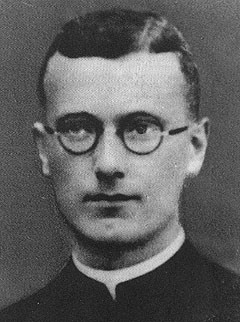 |
|
| |
Close up of the Reinisch
memorial.
--Erwin Ritter |
|
Father Reinisch in the pre
war years.
--Werner Kaligofsky |
|
In both Catholic Germany and Austria, Father
Reinisch is viewed as a significant figure in the early resistance
movement that opposed Hitler and the anniversary dates of his birth
and death are marked by public masses. Several memorials also exist
in Austria.
Gerd Palzer: In the Line of Duty
West German Customs Police Officer Gerd
Palzer was killed in the line of duty by gun fire while on border
patrol in the difficult terrain about 6 kilometers northwest along
the border from OP Sierra / Tennessee on 29 July, 1952. We often
forget just how hostile the border was in the early days. Large gaps
still existed in the forests and steep hill areas; the People’s
Police of the DDR were anxious to aggressively patrol the border in
search of potential escapees as well as score political points in
the new Cold War by any means possible. It was only in the 1990s,
well after the border was gone, that local historians were able to
fully research the Palzer story.
Apparently Plazer, on normal patrol,
encountered several Vopos on the border line by a clearing. The East
German police suddenly crossed into the West and tried to apprehend
Plazer. He resisted and broke away to the south. The Vopos opened
fire and Plazer, wounded, retreated further back. The Vopos followed
and Plazer was killed in a cross - fire some 100 meters inside of
West Germany. His body was then drug back to the DDR and placed
along the control strip. An American patrol recovered the body some
hours later. The Russians lodged a protest against both the Zoll
Police and US forces for twice causing major border incidents by
crossing into the DDR. A memorial stone to Plazer was placed in 1953
near the spot where he died. The incident is also fully recounted in
the Freedom’s Pathway Border Poster program that seeks to insure the
new generation recalls the sacrifices that occurred in the Rhoen
border region.
| |
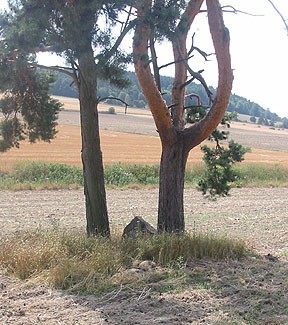 |
|
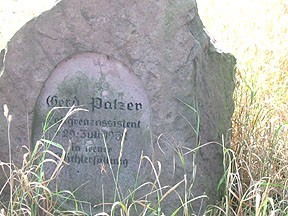 |
|
| |
On a hot German afternoon
in the former border area, the Palzer memorial.
--Erwin Ritter |
|
Detail of the Palzer
stone.
--Erwin Ritter |
|
One American Not Forgotten
Not too far from Bad Kissingen in the near
border area by Sondheim, a marker exists in memory of a GI killed in
an accident in 1946. Chances are, if you were involved in any aspect
of US Patrol during the Eaglehorse years, you drove by this spot
many times and probably never noticed the roadside marker. We are
still investigating the story and the versions differ slightly from
each source but here is what we know.
Tech 5 Roy Brookshire was only 19 years old
but home on leave in Colorado City, Texas, in the Summer of 1946, he
proudly told his parents and sister that he had re - enlisted.
Apparently this young man from the pan handle and found a new home
in the Army. Three months later, they laid him to rest in the
Lorreign Cemetery a few miles from Big Spring. The versions of the
accident vary in minor detail.
| |
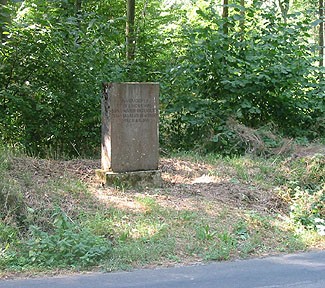 |
|
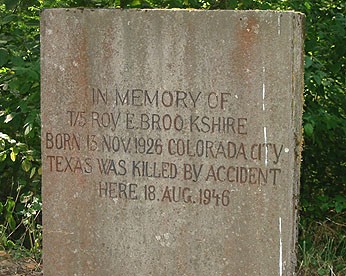 |
|
| |
Not far from Sondheim, the
memorial to Ray Brookshire.
--Erwin Ritter |
|
Detail of the Brookshire
stone.
--Erwin Ritter |
|
Erwin Ritter, investigating the story at the
German end reports, " ... Brookshire was riding on a tank as they
traveled down the road. A German vehicle was seen approaching in the
opposite direction and swerved across the road. To avoid the
collision, the tank ran into a ditch, Roy Brookshire was thrown off
and killed instantly. Roy’s surviving sister recalls the story in
much the same words. Another family member recalls, " ... Roy was
riding in a tanker when it went into a ditch to avoid the on coming
car, the truck overturned and Roy was killed ...".
We have yet to learn who was responsible for
the roadside marker. The style of carving suggests an American was
responsible, even if he misspelled Roy’s home town. Of the veterans
in our contact list who date back to Bad Kissingen in that immediate
post war period, no one could recall the incident. It remains to be
seen if he may have been assigned to the Constabulary unit in Coburg
or just a unit out on maneuvers.
The Brookshire family had received photos of
the marker some years back from another Eaglehorse trooper but had
misplaced them. We sent new images taken by Erwin Ritter to the
relatives. It is interesting to note that local Germans have kept
the area of the marker neatly cleared for anyone who may pass by and
take the time to read the inscription.
| |
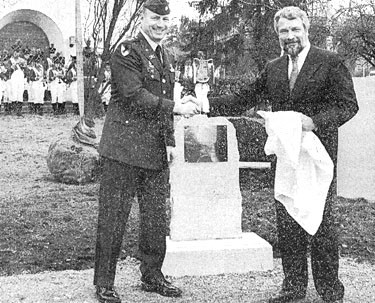 |
|
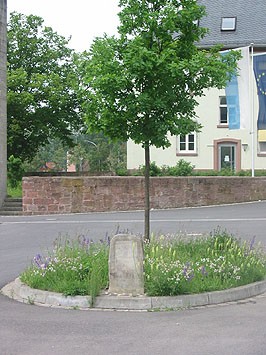 |
|
| |
At left, acting Blackhorse
Commander, LTC Robert Cone with Oberburgermeister Herr Christian
Zoll at the placing of the American plaque at the former Daley
Barracks. The chapel can be seen behind the Bad Kissingen Youth
Music Corps.
--Ritter / Main Post |
|
The same area as seen as
of 2003.
--Erwin Ritter |
|
The American Marker at Daley Barracks
Beyond the photos and captions, little is
known on the development of the memorial plaque that was placed at
the former Daley Barracks as the Blackhorse left Germany. We believe
the simple plaque said, " to recall the friendship between the city
of Bad Kissingen and the American Army, stationed at Daley Barracks,
1951 - 1991 " in both German and English. The official presentation
of the memorial was marked by great fanfare; the barracks area was
already in the process of passing over to German control and the
plaque was placed along with and planting of a tree to mark the
occasion, in the area immediately in front of the Chapel. The date
of the ceremony leads us to believe it was done shortly before the
Blackhorse officially departed Germany. In Fulda, a more ornate and
substantial marker recalls the service of the Regiment in Germany.
At some point, either after the official
return of the area or the redevelopment, the plaque was taken. At
first, we thought that the Bad Kissingen Office of Building
Inspections had saved the marker during the razing of the barracks.
This appears to not be the case. The plaque is gone, the Chapel is
gone, the tree remains.
| |
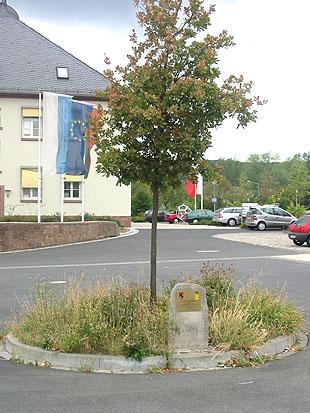 |
|
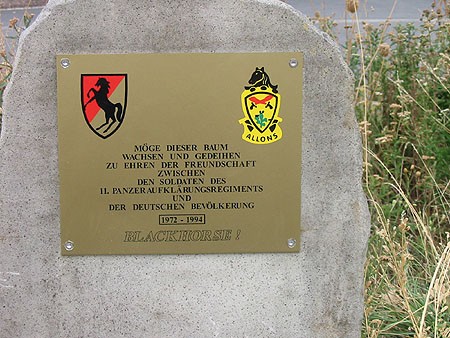 |
|
| |
The newly placed plaque at
the former Daley Barracks recalls the service of the Blackhorse in
Bad Kissingen.
--Erwin Ritter |
|
Detail of the new plaque
as of August 2003. Translated: "May this tree grow and be healthy to
honor the friendship between the soldiers of the 11th Armored
Cavalry Regiment and the German people. 1972 - 1994 Blackhorse!".
--Erwin Ritter |
|
UPDATE: In late August 2003, the plaque was
replaced through the efforts of the American military community and
the city of Bad Kissingen.
We Were There
Many American veterans with ties to Bad
Kissingen return each year. There have been organized tours and
certainly more will happen in the future. There is much to see and
recall in the town, the physical markers of our military time are a
little difficult to find but they are there also, in the LTA, at
Camp Lee, a few places in the old barracks area.
Many of the large German cities that once
hosted major American units have leveled the barracks areas and now,
virtually no trace remains. Bad Kissingen, however, was always
something different; the scale was smaller, personal contacts more
frequent and lasting. Whenever possible, the Americans tried to be
good neighbors as well as ready warriors, a delicate task. The
Kontact program promoting German and American positive interaction
was born in Bad Kissingen. We built a swimming pool, we built a by
pass road, we built personal friendships and a lasting peace in
Europe unparalleled in history. When we finally left, after a
victorious war, it was not fought in Germany but in the Middle East.
| |
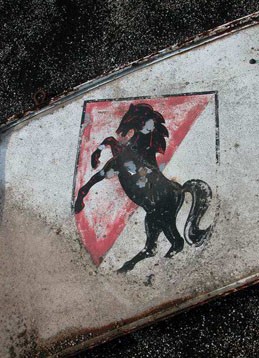 |
|
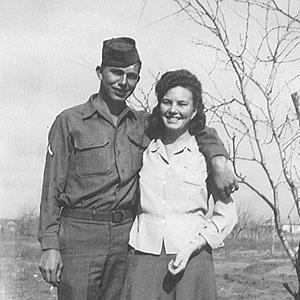 |
|
| |
A detail of the former
Camp Lee sign as found on the roof of the motor shop. The Blackhorse
fades away in the German sun.
--Norbert Ruckel |
|
Here is my brother, Roy
and my sister, Betty when Roy was home on leave in 1946.
--Mrs W.D. Doss |
|
How much had changed in just a few years.
The tanks marched out, the colors were folded and a fifty year
experience spanning three full generations of troopers and civilians
in one German town ended. When the Eaglehorse departed Daley for the
final time, the M1s and M3s passed under the gate arch and a
nineteen year old driver spun the vehicle into the " Wildflecken
turn " . Road marching along Ring Strasse it was a scene familiar to
both soldiers and civilians alike. This time, however, it was
different; from a distance, seen from the rear, the column began to
become indistinct in the heat plumes from the engines. A final
flurry of HUMVEEs and then the MPs released the German civilian
traffic by the gate. The sound began to die away and the tanks
became indistinct shapes in the far distance. Soon only the last
traces of the shimmering plumes were visible and then they were
gone. It was like a dream.
The sun set that day on a new Germany
and Europe at peace. Fifty years and thousands of troopers had
passed since the first day ... when LTC Spurrier watched his recon
battalion with scout jeeps, half tracks and M24 Chaffee tanks march
northwest from Schweinfurt to a new home and a new mission ... when
the first Americans came to Bad Kissingen.
| |
 |
|
| |
Roy's grave as we set him
to rest later that Summer.
--Mrs W.D. Doss |
|
|